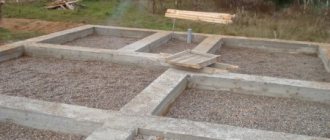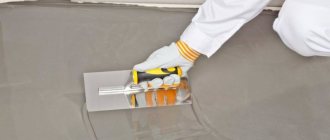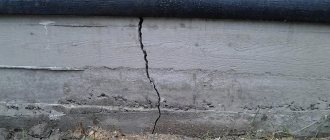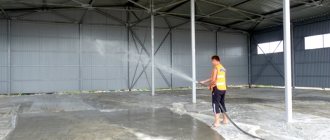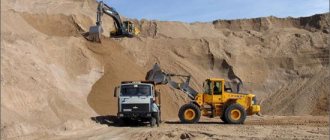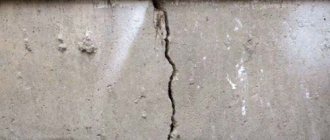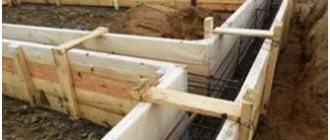What happens to the foundation after pouring?
After preparing the concrete mixture, it remains mobile for some time. This period is called setting. Before the solution has set, it must be delivered to the pouring site, placed in formwork, compacted in an accessible way and the surface leveled.
When purchasing concrete from a plant located far from the construction site, it is transported on a special vehicle with a rotating barrel - a concrete mixer. With constant stirring, bonds in the solution form much more slowly, which allows the setting period to prolong.
Delivery of concrete to the construction site Source beton-grodno.by
How long a concrete foundation for a house dries before it loses mobility depends on the time elapsed since production, weather conditions, air temperature, and the presence of additives in it that accelerate or retard hardening. In any case, we try to carry out the work of pouring, compacting and leveling as quickly as possible. With a large volume of concrete this can be difficult to do, so it is necessary to ensure a sufficient number of assistants. It is not recommended to fill the foundation in parts; it must be done in one go.
In the summer, concrete sets quickly, the very next day it does not sag underfoot and it may seem that the foundation is dry and work can continue. But this is not so: bonds have just begun to form in the material, turning the liquid solution into stone. This process occurs faster on the surface, from which water evaporates more actively, but inside the bonds are still very fragile.
The growth of connections occurs gradually and for quite a long time Source beton57.ru
How long the foundation must stand to gain good strength and final hardening also depends on a whole set of conditions:
- brand and composition of cement;
- amount of water in solution;
- air temperature;
- ambient humidity.
Therefore, before removing the formwork and starting to build walls, you should determine when this can be done without damaging the foundation.
See also: Catalog of companies that specialize in repairing foundations of any complexity
Concrete - foundation material
The main material in the manufacture of the foundation is concrete/reinforced concrete. Even if the foundation is supposed to be made prefabricated (for example, from foam blocks or concrete foundation blocks), concrete is used to construct a foundation pad and an armored belt along the top of the structure.
General information
Concrete is a short-term workability material. It is used on almost all construction sites, ranging from the construction of bridges, dams, multi-storey buildings and shopping centers to private houses and outbuildings on a personal plot. Of course, there are many types of concrete, each of which is characterized by certain properties that meet the requirements of the building's operation. Consequently, the composition of concrete for different types is also different. However, the basis of concrete is the components traditionally included in its composition:
- Binders are different brands of cement, with different chemical compositions. Thanks to the different composition, special properties of concrete (speed of strength gain, workability) are achieved for various operating conditions.
- Fillers - serve to create a frame and prevent cracks in concrete. They are divided into large and small. Coarse aggregate - crushed stone, pebbles, expanded clay or slag. As a rule, quartz sand is used as fine sand.
- Water for preparing the mixture.
If necessary, to impart the qualities required in a certain situation (frost resistance, acceleration/deceleration of hardening, economy), various chemical reagents and plasticizers are added.
It is highly undesirable to use water from unknown sources, from industrial wastewater, as well as sea, mineralized and swampy sources.
It is permissible to make a self-made concrete foundation for If a monolithic strip foundation is being poured for more “monumental” buildings, for example, a house of 100 square meters, then it is necessary (at a minimum, preferably) to use the delivery of ready-made material from a company that produces ready-mixed concrete. In this case, the foundation for the house will be a truly reliable support.
Pouring strip foundation from a mixer
Drying process
To carry out concreting correctly, it is not at all necessary to fully know all the chemical and physical processes. It is enough to remember that concrete hardening can be divided into 2 phases:
- setting - the wet mass quickly loses its plasticity, therefore all work on transporting, pouring, leveling and compacting the solution should be carried out promptly, everything should be prepared in advance (work site, access roads, etc.);
- final hardening - the material gains strength, becomes a “full-fledged building stone”, the first 3 days it gains 30% strength, 2 weeks - 70%, 4 - 100%, however, these data can be affected by various factors (temperature, humidity).
In order for concrete to gain its design strength, it must stand. At the same time, you should provide him with proper care.
Care
Concrete, as a building material, even if made from high-quality components, becomes useless if it is not properly maintained. Simply observing the time during which the foundation must settle may not be enough. It is necessary to provide protection to the concrete.
Concrete maintenance should begin immediately after compaction of the concrete mixture is completed. Maintenance time depends largely on the type of cement used in the mixture and the size and shape of the concrete structure.
Concrete care is a series of actions whose purpose is to maintain the hardening process of cement in concrete in order to obtain the desired properties, i.e. resistance to environmental influences during operation. As a rule, this concerns mechanical properties, frost resistance and resistance to aggressive chemicals. Proper maintenance involves controlling the temperature and movement of moisture both out of and into the concrete. Appropriate care includes:
- ensuring optimal conditions under which concrete is cured (providing appropriate humidity for the processes of cement hydration and temperature range for proper maturation of concrete);
- protection from the harmful effects of sunlight, wind and precipitation, as well as vibration, shock or other mechanical influences;
- limiting thermal stresses caused by the temperature difference between the surface and the interior of the concrete element (structure) - stresses can lead to cracking, reducing strength.
The optimal humidity at which concrete gains maximum strength is close to 100%, the ambient temperature range is 18 -20°C.
The longer moisture is retained in concrete, the better for all its properties. At low temperatures, it begins to be watered 24 hours after concreting. In hot weather, this procedure begins after 12 hours. Watering should be done every 4 hours and once at night.
Watering the foundation is very important
You can also protect concrete with PVC film - this will protect it from loss of moisture and, if it starts to rain, from its excess. Approximately watering is continued for 3-14 days. As a rule, this depends on the type of cement and the design features of the concrete element.
The foundation must dry evenly, therefore, if the formwork was dismantled early, watering should be continued, abundantly watering the dismantled areas.
What building codes say
Any concrete, regardless of the type of binder, should reach brand strength 28 days after production, subject to maturation at a temperature of about 200C and normal air humidity. Therefore, when determining how long the foundation should stand after pouring, all builders call this period. Often forgetting that lowering the temperature by 5-10 degrees greatly slows down this process.
In addition to more time, the “winter” foundation requires heating and special care Source kv-ind.com
For reference! Over time, the strength of concrete can become higher than that declared by the manufacturer, and its brand strength is used in the design and calculation of loads. If it has not reached this value, extreme loads can destroy it, so the foundation must stand.
When to remove formwork
According to building rules, foundation demolition is allowed when the concrete strength reaches 70% of the grade. How long the foundation must stand to become strong enough can be determined from the graph:
Graph for determining the strength of concrete M200-300 depending on temperature Source studfile.net
How long should the foundation dry?
The construction of a reliable foundation is carried out according to a pre-developed project in accordance with the technological process. It is necessary that the structure maintains heat and humidity conditions.
There are developed tables of ratios taking into account the class of concrete and strength.
After pouring, wait until the solution sets and hardens. Walls are erected only after the foundation has completely hardened. The correct composition of concrete and skilled work of builders make the foundation durable.
How long should the foundation harden?
Any developer should have this information. It is important to determine after what time the required strength appears.
A concrete foundation goes through two stages: setting and hardening. If you do not use methods and techniques to accelerate the readiness of the foundation, normal hardening conditions with a temperature of +20 are achieved 28 days after pouring naturally.
We are talking about the hardening speed of ordinary heavy concrete without additives using Portland cement, sand and crushed stone. An increase in temperature for every 10 degrees accelerates hardening by 2-4 times. The increase in strength with an outside temperature of +5 occurs 2-3 times slower than at a temperature of +30. Accordingly, on hot days the strip foundation will harden faster.
Drying concrete
The main indicator that does not depend on a person is weather conditions. In order for concrete to turn into a solid composition, positive temperatures are needed.
In addition to air temperature, the drying process is affected by:
- Concrete grade;
- Composition of cement;
- Manufacturing plant;
- Compaction of concrete mortar;
- Foundation pouring technology;
- Solution recipe and percentage of water.
Drying is also affected by the type of soil. Heaving soils in a moistened, soaked state during the period of freezing increase in volume, put pressure on the foundation and push it out. This can lead to unevenness, warping, cracking, or failure of the entire foundation.
Construction on heaving soils requires a set of special engineering solutions.
When to dismantle the formwork
The foundation formwork for a bathhouse, garage or house is removed after seven days. Until this time, the object is inspected several times. The composition is checked using a concrete strength meter. After removing the formwork, another strength check is done.
There are precedents in construction when the formwork is removed within a day. They are guided by the fact that concrete begins to harden forty minutes after laying. A risky approach to business, and the risk is not always justified.
There is no need to rush to dismantle the formwork. It is better to once again make sure that the composition has set and acquired formwork strength.
When can you build walls?
There was an opinion that before installing the walls, it was necessary to allow the foundation to settle all winter without load. It was explained by the need for subsidence, then construction could continue. Now the version is more like a myth.
When a house is being built, well-compacted soil lies at the freezing depth. If the soil is subsiding, preparation is made of crushed stone with geotextiles. The preparation is loaded with the weight of the sole and the tape. There is nowhere for the compacted soil to settle further.
The walls are erected in stages, the load increases gradually. Full load of the house up to 100% occurs in 2-3 years. Experienced builders and design engineers warn that a foundation left without walls and roof all winter becomes defenseless against negative pressure from heaving soils. There is a risk of its destruction and deformation.
Within a month, the composition will finally harden and the walls can be erected. To avoid cracks and other troubles, concrete must gain at least 70% strength. Then they begin laying walls, slabs, and ceilings.
How to speed up concrete hardening
The period of 7-10 days for concrete to gain approximate formwork strength is not always satisfactory for builders.
There are certain methods and techniques that accelerate hardening:
- Heat and moisture treatment is the simplest, most well-known and proven method. They are processed by directional, surface or electrical heating in heat-moisture chambers and cabinets. The design must always maintain the required mode;
- Additives with salts of inorganic acids, nitrates of potassium, calcium, sodium, aluminum. Electrolytes increase the solubility of cement minerals. As a result, the reaction speeds up. Laboratory tests provide an accurate answer to the use of specific additives;
- Concrete mixtures with a low water-cement ratio. The less water, the faster the water and cement become saturated. A stiffer mixture with a low CV hardens faster. Superplasticizers reduce the amount of water by lowering the water to cement ratio;
- Microsilica as a by-product of chemical production. It has the composition of quartz sand. It is one of the best solutions in the production of high-strength and high-quality concrete. If the product concentration decreases, the reaction tends to replenish. In the first day, the strength reaches 50-80%. To reduce the amount of water, the latest generation of superplasticizers are used;
- Specialty cements such as high surface area rapid hardening Portland cement and aluminous cement. After two or three days they give 50-100% strength.
Acceleration of drying most often has a direct bearing on winter concreting. At zero temperature, strength development practically stops. Water turns into ice and disrupts the previously formed structure. As the temperature rises, the strength continues to gain strength.
Video description
To accurately determine the strength of the foundation and the possibility of continuing work, you can use a special device - a sclerometer.
How to use it, watch in this video: It is worth noting that walls alone do not provide the full design load on the foundation, which must also withstand the weight of floors, roofing and other structures. Therefore, the answer to the question of how long it takes to load the foundation after pouring is always individual, and largely depends on the material of the walls. As a rule, 70-80% is quite enough to start building a wooden house or raising walls from light concrete blocks.
What does increasing hardening time mean?
After the standard 28 days, the processes of formation and strengthening of bonds in concrete do not stop; it continues to gain strength. From which we can conclude that the longer it stands without load, the better. But it is not so.
The fact is that the parameters of the foundation, in particular its depth, are calculated based on the loads. The weight pressing on it must counteract the buoyancy forces of the soil, especially if it is prone to frost heaving. Left unloaded for the winter, the foundation may crack under the influence of these forces.
Photo fact: a crack in the foundation that appeared in winter Source blog-potolok.ru
When deciding how long the foundation should sit after pouring for a house, you need to take into account the time of year. In spring and summer it can be given several months. In the fall, it’s better to hurry and start building walls. If this is not possible, the base must be preserved for the winter, covered with straw or sawdust on top, and snow retention arranged around the perimeter.
Briefly about the main thing
The cost of the foundation can reach 20-30% of the cost of building a house, and repairing it is more difficult than other structures due to its location in the ground and the large load-bearing load. Therefore, its strength and reliability must be ensured immediately, without neglecting the requirements of construction technology. In this case, it is important to determine how long the foundation should dry after pouring, focusing primarily on the air temperature. The notorious 28 days is the time during which concrete gains strength at 20 degrees. If the weather is cool, more may be needed.
Ratings 0
Shrinkage of the foundation of a house: how long should the foundation stand?
During the construction of the foundation (foundation, support) for a house, it is necessary to take into account many factors - soil density, depth level, type of concrete, shrinkage time and others. All these factors are interconnected, but the main one is the shrinkage time.
Without taking this factor into account, it is impossible to build a high-quality foundation for a house.
So, let’s figure out how long the foundation should stand (dry) after installation.
Why is it important to consider shrinkage?
Foundation for a house made of timber
The strength of the walls and the service life of the house depend on the foundation. The base distributes the mass of the structure over a large area, resulting in reduced pressure on the ground. If the soil is hard and durable (rock), then subsidence after installation will be minimal.
If the house is built on clay or sandy soils, then it will take at least 12 months for proper shrinkage after installation. During this time, the soil under the foundation will become so compacted that it will no longer sag under its weight.
If you do not give time for proper shrinkage, then after the building is installed, the load on the uncompacted areas of the soil will increase, which will lead to subsidence of one of the walls of the house.
The result is cracks, destruction of the integrity of the building and the need for expensive major repairs, and often complete reconstruction. Therefore, a properly constructed foundation must stand sufficiently before construction.
How to determine the time required for proper shrinkage
Consequences of unsuccessful foundation construction
To determine how long the foundation should stand before building walls, the following factors must be carefully analyzed:
- results of geodetic and engineering research;
- average annual precipitation;
- soil freezing temperature;
- deepening the foundation;
- foundation type;
- materials from which the foundation is made;
- mass of the finished structure.
As a result of geodetic research and engineering surveys, the structure of the soil and its characteristics are determined. This data allows you to determine how the soil will behave under the influence of the base and the entire structure and how long it will take to compact it.
The condition of the soil changes in different seasons and it reacts differently to the pressure arising from the weight of the foundation and walls.
Incorrect determination of the characteristics of the earth will lead to the fact that in winter or after heavy rains it will sag and cracks will cover the wall of the house. All these parameters determine how much time is needed for the foundation to shrink correctly, without which it makes no sense to proceed with further construction.
What happens during shrinkage
Cracks on the walls of a house are the first signs of subsidence of the foundation
After concrete is poured, several parallel processes occur. The strength of concrete increases and after 12-18 months reaches values close to maximum. The mass of the slab compacts the soil, squeezing particles of clay, sand and other substances. Along with the seasons, soil characteristics such as moisture and mobility also change.
The slab pushes the earth until it reaches the point where the influence of other factors becomes too insignificant. It is impossible to determine how long these processes take. Therefore, the time that the foundation should stand is determined on the basis of geodetic research.
Only on such a foundation is it possible to carry out installation work and build a strong and reliable house.
In regions where winter temperatures drop below minus 10 degrees Celsius, the pit depth should be below the freezing depth. Therefore, the finished base must stand longer, because the temperature at such a depth never drops below 0.3 and does not rise above 5 degrees Celsius.
Crushed stone as a filler for concrete mortar for pouring a foundation
At this distance from the surface, the influence of rainwater runoff is too small, so the shrinkage process occurs under the influence of groundwater. When determining how long the foundation should sag, be sure to take into account the depth of freezing. Otherwise, there is a high probability of damage to the foundation and the walls of the house located on it.
Why does shrinkage occur incorrectly?
An example of a building erected without preliminary shrinkage of the foundation
During preparatory work (digging a pit, creating a sand and crushed stone cushion) or installation, all factors had to be taken into account. Otherwise, there is a high probability that the shrinkage of the foundation, which according to calculations should occur correctly, will proceed unevenly.
This also happens if under the base there are areas of soil with different densities or humidity. In this case, the concrete will sag only where the soil is drier and harder.
As a result, the foundation, which should evenly distribute the weight of the building over the entire area of the ground, will not cope with its responsibilities. The house will not be able to stand reliably on such a foundation.
If the bottom of the pit is located above the freezing depth, then proper shrinkage is impossible, regardless of how long it stood after installation. In winter, as a result of frost heaving, the soil level rises.
This happens unevenly, strong in some places and weak in others.
As a result, part of the concrete rises above the ground level, which creates a breaking force. As long as no walls are built on the foundation, heaving lifts the entire foundation without any problems. After the construction of the building, the mass of the base increases many times and frost heaving leads to its fracture.
And after this, cracks appear in the walls. This phenomenon is especially dangerous if the house has a strip foundation rather than a slab foundation.
How to determine that shrinkage has ended
Uniform subsidence will avoid the destruction of buildings
All processes associated with soil compaction occur so slowly that it is impossible to visually determine their completion. Therefore, the end of shrinkage is determined on the basis of calculations in which all factors are taken into account.
If there is an error in one of the values used for such calculations, then there is a high probability that the entire process will not proceed correctly.
There are known cases when a team of builders erected a house, but incorrectly determined the characteristics and properties of the soil.
Six months later, under the influence of the ongoing subsidence of the foundation, deep cracks appeared. By allowing the foundation to sit for another 5-10 months, they would have avoided problems. Therefore, experienced builders, having calculated how long the foundation should stand, add another 5-10 months to this time.
This increases the installation time of the house, but greatly reduces the likelihood of improper shrinkage of the base and sagging of the walls.
How to determine shrinkage time without geodetic research
Consequences of incorrect calculations
To determine how long the foundation should stand before installing the walls, consider the following:
- On rocky soils 3-5 months;
- On dry clay and sandy soils 8-12 months;
- On wet soils 15-20 months;
- On marshy soils 20-30 months.
This is only true after the following requirements are met:
- only high-quality materials should be used for the base;
- the foundation must be below the freezing depth;
- for strip foundations, the ratio of the width of the wall, base and pillows should be no less than 1:2 and 1:2. That is, the width of the base should be at least 2 times the width of the wall. And the width of the pillow is at least 2 times the width of the base;
- the foundation should stand on a loosened cushion (fraction of the lower layer is 70-90 mm, the middle layer is 30-60 mm, the top layer is 10-20 mm);
- underground groundwater drainage must be performed;
- rainwater drainage must be carried out.
A simple technology for leveling the foundation with concrete mortar
Conclusion
Before building a house, it is necessary to allow the foundation to stand and allow complete shrinkage. If this is not done, the new house will quickly begin to collapse.
fundamentclub.ru
